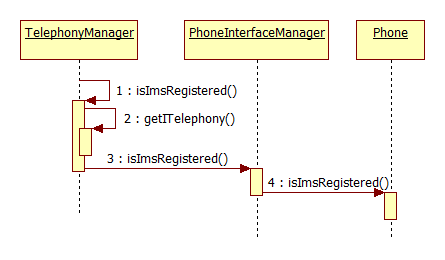Android Telephony分析(四) ---- TelephonyManager详解
前言
TelephonyManager主要提供Telephony相关信息的查询/修改功能,以及Phone状态监听功能,封装的方法主要是提供给APP上层使用。
TelephonyManager.java 在frameworks\base\telephony\java\android\telephony目录下。
1. TelephonyManager整体结构
从TelephonyManager导入的文件中可以发现有四个接口
import com.android.internal.telecom.ITelecomService;
import com.android.internal.telephony.IPhoneSubInfo;
import com.android.internal.telephony.ITelephony;
import com.android.internal.telephony.ITelephonyRegistry;分别对应下面这几个AIDL接口:
\frameworks\base\telecomm\java\com\android\internal\telecom\ITelecomService.aidl
\frameworks\base\telephony\java\com\android\internal\telephony\IPhoneSubInfo.aidl
\frameworks\base\telephony\java\com\android\internal\telephony\ITelephony.aidl
\frameworks\base\telephony\java\com\android\internal\telephony\ITelephonyRegistry.aidl所以可以猜测到,在TelephonyManager中可以得到这四种Service。
通过所有文件中搜索”extends 接口名.Stub”,如”extends ITelephony.Stub”,可以找到是哪些类实现了上面四个AIDL接口中的方法,整理可得:

在TelephonyManager中搜索”接口名.Stub.asInterface”,如”ITelephony.Stub.asInterface”,可以找到这四个Service的名字,整理可得:
| 接口 | 服务端 | Service Name |
|---|---|---|
| ITelecomService.aidl | TelecomServiceImpl.java | telecom (TELECOM_SERVICE) |
| IPhoneSubInfo.aidl | PhoneSubInfoController.java | iphonesubinfo |
| ITelephony.aidl | PhoneInterfaceManager.java | phone (TELEPHONY_SERVICE) |
| ITelephonyRegistry.aidl | TelephonyRegistry.java | telephony.registry |
好了,下面分别对这四种Service进行分析:
本文来自 http://blog.csdn.net/linyongan ,转载请务必注明出处。
1.1 TelecomServiceImpl—Telecom Service
服务端TelecomServiceImpl中有mBinderImpl实现了ITelecomService接口中的方法
public class TelecomServiceImpl {
private final ITelecomService.Stub mBinderImpl = new ITelecomService.Stub() {
...
}
}在TelecomLoaderService.java中,TelecomServiceImpl把自己注册到ServiceManager中,
ServiceManager.addService(Context.TELECOM_SERVICE, service);所以在TelephonyManager中可以通过ServiceManager得到Telecom Service
private ITelecomService getTelecomService() {
//得到TelecomServiceImpl的代理对象
return ITelecomService.Stub.asInterface(ServiceManager.getService(Context.TELECOM_SERVICE));
}其实Telecom Service的最常用客户端是TelecomManager.java。而在TelephonyManager中由于无法得到CallManager对象,所以只能依赖Telecom Service获取Call State。
/**
* Returns one of the following constants that represents the current state of all
* phone calls.
*
* {@link TelephonyManager#CALL_STATE_RINGING}
* {@link TelephonyManager#CALL_STATE_OFFHOOK}
* {@link TelephonyManager#CALL_STATE_IDLE}
*/
public int getCallState() {
try {
ITelecomService telecom = getTelecomService();
if (telecom != null) {
return telecom.getCallState();
}
} catch (RemoteException e) {
Log.e(TAG, "Error calling ITelecomService#getCallState", e);
}
return CALL_STATE_IDLE;
}所以,总体上来说,虽然TelecomManager得到了Telecom Service,但其实作用不大。相反,Telecom Service中会反过来得到TelephonyManager对象,进一步实现自己的方法,如在TelecomServiceImpl.java中:
public String getVoiceMailNumber(PhoneAccountHandle accountHandle, String callingPackage) {
...
return getTelephonyManager().getVoiceMailNumber(subId);
...
}
private TelephonyManager getTelephonyManager() {
return (TelephonyManager)mContext.getSystemService(Context.TELEPHONY_SERVICE);
}1.2 PhoneSubInfoController— “iphonesubinfo” Service
服务端PhoneSubInfoController继承自IPhoneSubInfo.Stub
public class PhoneSubInfoController extends IPhoneSubInfo.Stub {在创建Default Phone对象之后,ProxyController对象在PhoneFactory.java的makeDefaultPhone()中被初始化
public static void makeDefaultPhone(Context context) {
...
//先初始化ProxyController
mProxyController = ProxyController.getInstance(context, sProxyPhones,
mUiccController, sCommandsInterfaces);
...
}
private ProxyController(Context context, PhoneProxy[] phoneProxy, UiccController uiccController,
CommandsInterface[] ci) {
...
//在ProxyController的构造方法中初始化了PhoneSubInfoController对象
mPhoneSubInfoController = new PhoneSubInfoController(mContext, mPhones);
...
}
public PhoneSubInfoController(Context context, Phone[] phone) {
mPhone = phone;
if (ServiceManager.getService("iphonesubinfo") == null) {
//将PhoneSubInfoController实例注册到ServiceManager中
ServiceManager.addService("iphonesubinfo", this);
}
mContext = context;
mAppOps = (AppOpsManager) mContext.getSystemService(Context.APP_OPS_SERVICE);
}所以在TelephonyManager中可以通过ServiceManager得到”iphonesubinfo” Service
private IPhoneSubInfo getSubscriberInfo() {
// get it each time because that process crashes a lot
return IPhoneSubInfo.Stub.asInterface(ServiceManager.getService("iphonesubinfo"));
}通过”iphonesubinfo” Service可以得到software version、deviceID、VoiceMail Number等信息,TelephonyManager在这里只是对这些方法进一步封装,这些方法具体的实现,最后还是通过Phone实例和IsimRecords实例来完成的。
以getMsisdn()方法为例,最常见的调用方式如下:

备注:在Android N中已删除PhoneSubInfo.java和PhoneSubInfoProxy.java,所以流程变得简单了。
1.3 PhoneInterfaceManager—Telephony Service
TelephonyManager依赖Telephony Service实现了大部分的方法。
PhoneInterfaceManager继承自ITelephony.Stub
public class PhoneInterfaceManager extends ITelephony.Stub {PhoneInterfaceManager.java在 packages\services\telephony\src\com\android\phone目录下,显然它是运行在Phone进程中的。
在Phone进程启动时,Default Phone对象创建完之后,PhoneInterfaceManager对象在PhoneGlobals的onCreate()中被初始化:
public void onCreate() {
...
phoneMgr = PhoneInterfaceManager.init(this, PhoneFactory.getDefaultPhone());
...
}
/* package */ static PhoneInterfaceManager init(PhoneGlobals app, Phone phone) {
synchronized (PhoneInterfaceManager.class) {
if (sInstance == null) {
//初始化PhoneInterfaceManager
sInstance = new PhoneInterfaceManager(app, phone);
} else {
Log.wtf(LOG_TAG, "init() called multiple times! sInstance = " + sInstance);
}
return sInstance;
}
}在PhoneInterfaceManager的构造方法中:
private PhoneInterfaceManager(PhoneGlobals app, Phone phone) {
//得到一些关键类
mApp = app;
mPhone = phone;
mCM = PhoneGlobals.getInstance().mCM;
mUserManager = (UserManager) app.getSystemService(Context.USER_SERVICE);
mAppOps = (AppOpsManager)app.getSystemService(Context.APP_OPS_SERVICE);
mMainThreadHandler = new MainThreadHandler();
mTelephonySharedPreferences =
PreferenceManager.getDefaultSharedPreferences(mPhone.getContext());
mSubscriptionController = SubscriptionController.getInstance();
publish();
}
private void publish() {
//将PhoneInterfaceManager实例注册到ServiceManager中
ServiceManager.addService("phone", this);
}在PhoneInterfaceManager初始化的时候,把自己注册成SystemServer,这样客户端(如TelephonyManager)则可以通过ServiceManager把它取出来。
private ITelephony getITelephony() {
//得到PhoneInterfaceManager的代理对象
return ITelephony.Stub.asInterface(ServiceManager.getService(Context.TELEPHONY_SERVICE));
}PhoneInterfaceManager中的方法,最后还是通过Phone实例来实现。
以isImsRegistered()方法为例,最常见的调用方式如下:

1.4 TelephonyRegistry—“telephony.registry” Service
TelephonyRegistry继承自ITelephonyRegistry.Stub
class TelephonyRegistry extends ITelephonyRegistry.Stub {在SystemServer.java中,
telephonyRegistry = new TelephonyRegistry(context);
//将TelephonyRegistry实例注册到ServiceManager中
ServiceManager.addService("telephony.registry", telephonyRegistry); 所以在TelephonyManager中可以通过ServiceManager得到”telephony.registry” Service
if (sRegistry == null) {
sRegistry = ITelephonyRegistry.Stub.asInterface(ServiceManager.getService(
"telephony.registry"));
}TelephonyManager主要利用”telephony.registry” Service实现listen()方法,实现对Phone状态的监听的功能
public void listen(PhoneStateListener listener, int events) {
if (mContext == null) return;
try {
Boolean notifyNow = (getITelephony() != null);
sRegistry.listenForSubscriber(listener.mSubId, getOpPackageName(),
listener.callback, events, notifyNow);
} catch (RemoteException ex) {
// system process dead
} catch (NullPointerException ex) {
// system process dead
}
}关于TelephonyRegistry,后续的文章会详细讲,目前先不用太关注。
2. 如何得到TelephonyManager对象
1、 假如没有Context,可以通过:
private static TelephonyManager sInstance = new TelephonyManager();
public static TelephonyManager getDefault() {
return sInstance;
} 2、如果能得到Context对象,可以通过:
//注意,这是从SystemService中取
TelephonyManager tm = (TelephonyManager) context.getSystemService(Context.TELEPHONY_SERVICE);
//或者
TelephonyManager mTelephonyManager = TelephonyManager.from(context);3. 其他重要方法
TelephonyManager还提供了两个其他比较重要的方法:
/**
* Gets the telephony property.
*
* @hide
*/
public static String getTelephonyProperty(int phoneId, String property, String defaultVal) {
String propVal = null;
//根据key获取到value
String prop = SystemProperties.get(property);
if ((prop != null) && (prop.length() > 0)) {
//将value分割成字符串数组
String values[] = prop.split(",");
if ((phoneId >= 0) && (phoneId < values.length) && (values[phoneId] != null)) {
//取出phoneId对应的value
propVal = values[phoneId];
}
}
return propVal == null ? defaultVal : propVal;
}
/**
* Sets the telephony property with the value specified.
*
* @hide
*/
public static void setTelephonyProperty(int phoneId, String property, String value) {
...
}这样子就可以实现对于同一个key,不同phoneId可以存储不同的值。